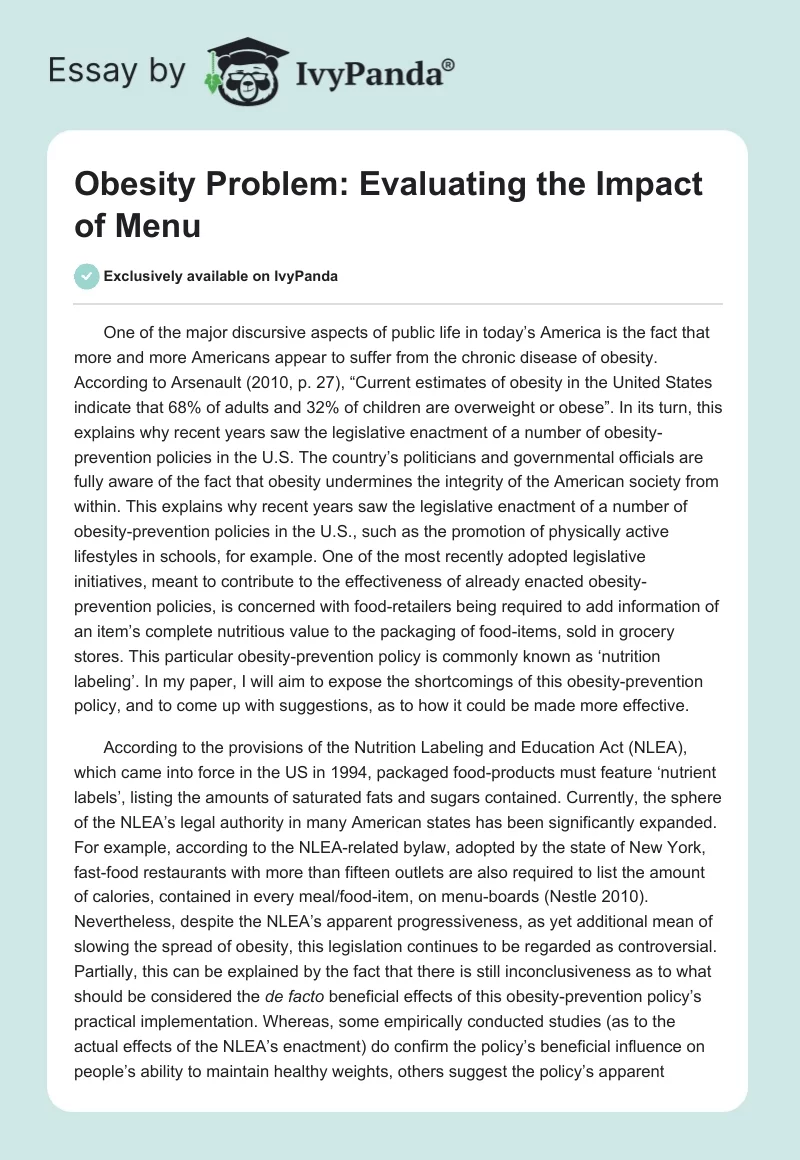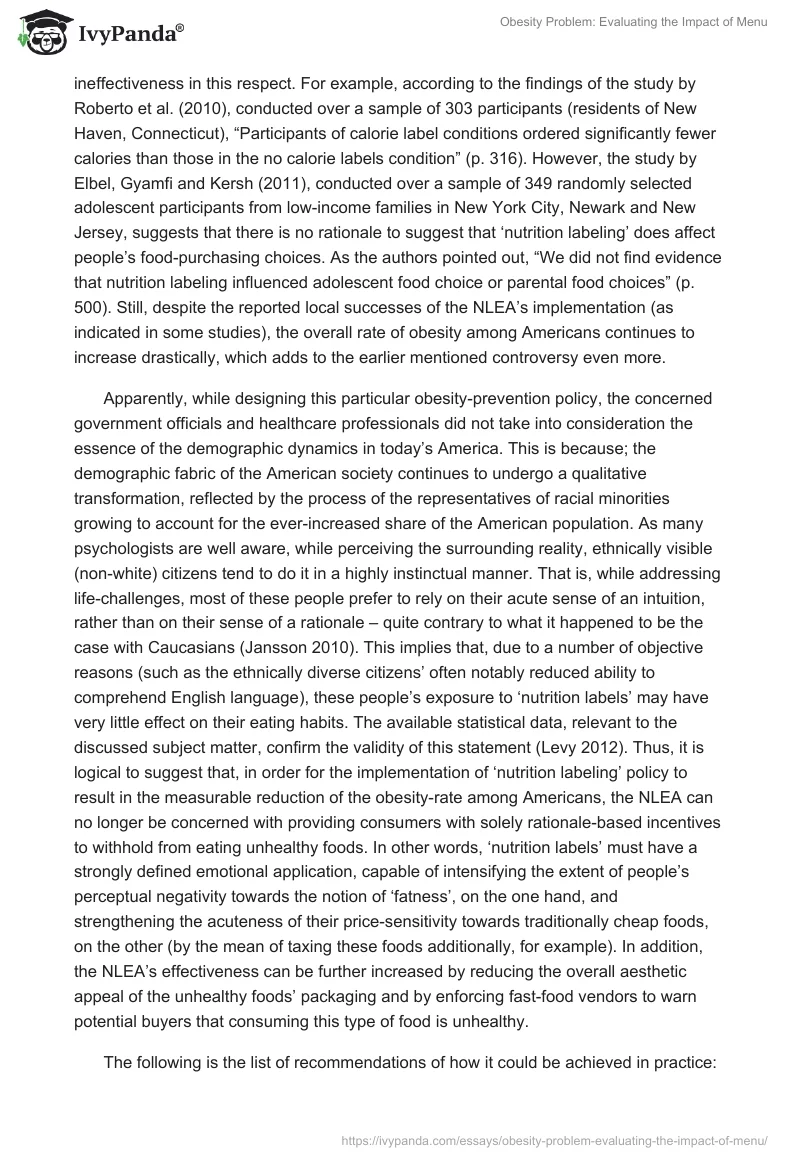One of the major discursive aspects of public life in today’s America is the fact that more and more Americans appear to suffer from the chronic disease of obesity. According to Arsenault (2010, p. 27), “Current estimates of obesity in the United States indicate that 68% of adults and 32% of children are overweight or obese”. In its turn, this explains why recent years saw the legislative enactment of a number of obesity-prevention policies in the U.S. The country’s politicians and governmental officials are fully aware of the fact that obesity undermines the integrity of the American society from within. This explains why recent years saw the legislative enactment of a number of obesity-prevention policies in the U.S., such as the promotion of physically active lifestyles in schools, for example. One of the most recently adopted legislative initiatives, meant to contribute to the effectiveness of already enacted obesity-prevention policies, is concerned with food-retailers being required to add information of an item’s complete nutritious value to the packaging of food-items, sold in grocery stores. This particular obesity-prevention policy is commonly known as ‘nutrition labeling’. In my paper, I will aim to expose the shortcomings of this obesity-prevention policy, and to come up with suggestions, as to how it could be made more effective.
According to the provisions of the Nutrition Labeling and Education Act (NLEA), which came into force in the US in 1994, packaged food-products must feature ‘nutrient labels’, listing the amounts of saturated fats and sugars contained. Currently, the sphere of the NLEA’s legal authority in many American states has been significantly expanded. For example, according to the NLEA-related bylaw, adopted by the state of New York, fast-food restaurants with more than fifteen outlets are also required to list the amount of calories, contained in every meal/food-item, on menu-boards (Nestle 2010). Nevertheless, despite the NLEA’s apparent progressiveness, as yet additional mean of slowing the spread of obesity, this legislation continues to be regarded as controversial. Partially, this can be explained by the fact that there is still inconclusiveness as to what should be considered the de facto beneficial effects of this obesity-prevention policy’s practical implementation. Whereas, some empirically conducted studies (as to the actual effects of the NLEA’s enactment) do confirm the policy’s beneficial influence on people’s ability to maintain healthy weights, others suggest the policy’s apparent ineffectiveness in this respect. For example, according to the findings of the study by Roberto et al. (2010), conducted over a sample of 303 participants (residents of New Haven, Connecticut), “Participants of calorie label conditions ordered significantly fewer calories than those in the no calorie labels condition” (p. 316). However, the study by Elbel, Gyamfi and Kersh (2011), conducted over a sample of 349 randomly selected adolescent participants from low-income families in New York City, Newark and New Jersey, suggests that there is no rationale to suggest that ‘nutrition labeling’ does affect people’s food-purchasing choices. As the authors pointed out, “We did not find evidence that nutrition labeling influenced adolescent food choice or parental food choices” (p. 500). Still, despite the reported local successes of the NLEA’s implementation (as indicated in some studies), the overall rate of obesity among Americans continues to increase drastically, which adds to the earlier mentioned controversy even more.
Apparently, while designing this particular obesity-prevention policy, the concerned government officials and healthcare professionals did not take into consideration the essence of the demographic dynamics in today’s America. This is because; the demographic fabric of the American society continues to undergo a qualitative transformation, reflected by the process of the representatives of racial minorities growing to account for the ever-increased share of the American population. As many psychologists are well aware, while perceiving the surrounding reality, ethnically visible (non-white) citizens tend to do it in a highly instinctual manner. That is, while addressing life-challenges, most of these people prefer to rely on their acute sense of an intuition, rather than on their sense of a rationale – quite contrary to what it happened to be the case with Caucasians (Jansson 2010). This implies that, due to a number of objective reasons (such as the ethnically diverse citizens’ often notably reduced ability to comprehend English language), these people’s exposure to ‘nutrition labels’ may have very little effect on their eating habits. The available statistical data, relevant to the discussed subject matter, confirm the validity of this statement (Levy 2012). Thus, it is logical to suggest that, in order for the implementation of ‘nutrition labeling’ policy to result in the measurable reduction of the obesity-rate among Americans, the NLEA can no longer be concerned with providing consumers with solely rationale-based incentives to withhold from eating unhealthy foods. In other words, ‘nutrition labels’ must have a strongly defined emotional application, capable of intensifying the extent of people’s perceptual negativity towards the notion of ‘fatness’, on the one hand, and strengthening the acuteness of their price-sensitivity towards traditionally cheap foods, on the other (by the mean of taxing these foods additionally, for example). In addition, the NLEA’s effectiveness can be further increased by reducing the overall aesthetic appeal of the unhealthy foods’ packaging and by enforcing fast-food vendors to warn potential buyers that consuming this type of food is unhealthy.
The following is the list of recommendations of how it could be achieved in practice:
- Nutrition-labels should contain images of grossly overweight individuals, as a means of encouraging consumers to choose a low-fat diet. As it was pointed out earlier, the factual information, contained in ‘nutrition labels’ on the calorie-rich foods’ packaging, is simply not emotionally-appealing enough. Many people also find it hard to understand. Therefore, food-retailers should be required to supplement this information with the images of what happens to people who indulge in overeating and/or consuming high amounts of fat. This should substantially reduce the perceptual appeal of unhealthy foods.
- Consumers should be discouraged from associating calorie-rich foods with the notion of affordability. It is a commonplace assumption that the price of calorie-rich foods is comparatively low. In its turn, this provides price-conscious individuals with an additional incentive to remain ignorant to the negative effects of consuming ‘fattening’ food-items. Therefore, government officials should consider passing new legislations, which would forbid food-retailers from advertising unhealthy foods, as being particularly affordable.
- Food-retailers should be required to offer calorie-rich foods in ‘plain’ (aesthetically unappealing) packaging. Fast-food chains should also withhold from subjecting consumers to different forms of a psychological manipulation (such as offering them to ‘upsize’ their meals).
Even though, as it was mentioned earlier, the price of most calorie-rich food is comparatively low, the revenue generated from selling it still allows retailers to invest heavily in appealing packaging of this food. In its turn, this provides an additional momentum to the epidemic of obesity in the U.S. This situation, of course, can no longer be considered tolerable.
I believe the earlier arguments, as to what account for the NLEA obesity-prevention policy’s conceptual shortcomings, and as to what could be done, in order to increase the extent of this policy’s effectiveness, fully correlates with the paper’s initial suggestion.
References
Arsenault, J 2010, ‘Can nutrition labeling affect obesity?’, The Magazine of Food, Farm & Resource Issues, vol. 25 no 3, pp. 27-30.
Elbel, B, Gyamfi, J & Kersh, R 2011, ‘Child and adolescent fast-food choice and the influence of calorie labeling: a natural experiment’, International Journal of Obesity, vol. 35 no 4, pp. 493-500.
Jansson, D 2010, ‘Racialization and “Southern” identities of resistance: a psychogeography of internal Orientalism in the United States’, Annals of the Association of American Geographers, vol. 100 no.1, pp. 202-221.
Levy, D et al. 2012, ‘Food choices of minority and low-income employees: a cafeteria intervention’, American Journal of Preventive Medicine, vol. 43 no. 3, pp. 240-248.
Nestle, M 2010, ‘Health care reform in action-calorie labeling goes national’, The New England Journal of Medicine, vol. 362 no. 25, pp. 2343-2345.
Roberto, C et al. 2010, ‘Evaluating the impact of menu labeling on food choices and intake’, American Journal of Public Health, vol. 100 no. 2, pp. 312-318.


